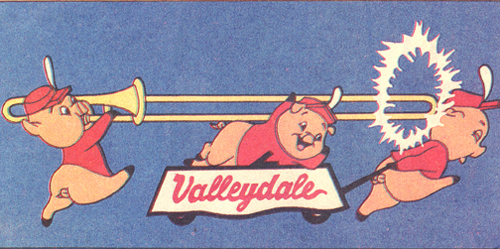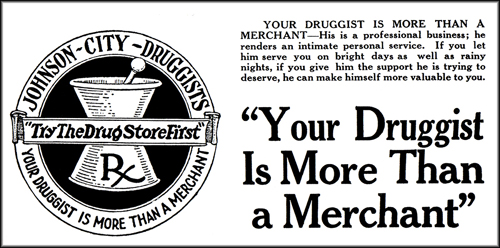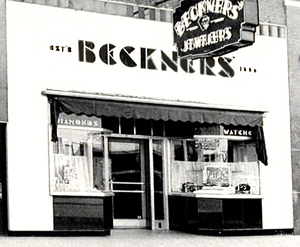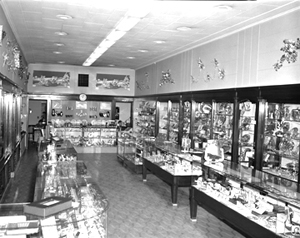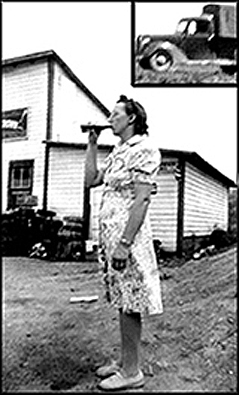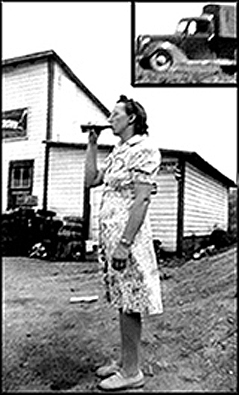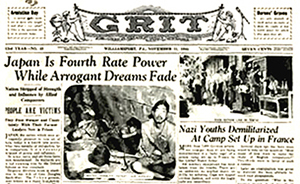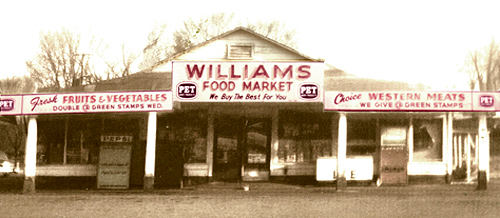“The music goes zoom zoom; The drummer goes boom boom; And everybody shouts, Hurray for Valleydale; Hurray for Valleydale; All hail, it's Valleydale. (cymbal) Valleydale sausage; (cymbal) Valleydale wieners; (cymbal) Valleydale bacon; Zing, zing, zing, zing, Valleydale; Hurray for Valleydale; All hail, it's Valleydale.”
In 1956, Valleydale Packers, Inc., located in Salem, VA, sought a way to make the public keenly aware of its meat products. They devised a clever animated television commercial featuring cute cuddly pigs, dressed in band uniforms, singing about Valleydale products. People all over the area soon fell in love with the little curly-tailed critters and began harmonizing the commercial’s snappy tune. It became one of the most recognized television ads in East Tennessee history.

The little hogs eventually appeared in 12 different television commercials, one humorously known as the Green Bay Porkers. Perhaps the most recognizable one was a 30-second clip of eight charming little swine marching in a parade to the approbation of a cheering crowd lining the streets.
The first two pigs carried a large drum and one played it. A third porker rode on top of it pounding cymbals. The fourth and fifth piglets trailed behind with one poking the other in the head as his trombone slide went forward and backward. The sixth one was modestly stretched out on a Valleydale float. Next came pig #7 marching and playing cymbals with a different meat product displayed with each clash – “Valleydale Sausage, Valleydale Weenee, Valleydale Bacon.” The final hog, an adorable little baton-twirling majorette, performed for the crowd and simultaneously displayed additional meat products.
A second commercial was almost identical to the first but featured a few different frames, such as having the pigs alternately march forward, then backward and forward again. This time, only six pigs were featured.
In a third ad, three little piggies are escorted onto the framework of a large building riding a narrow I-beam, being hoisted by a third little pig who precariously let each one off at a different floor. One pig initially threw hot rivets to the other pigs and then predictably switched to tossing Valleydale products to them presumably for lunch.
Another commercial featured a five-piece pig jazz band, consisting of a trumpet, Sousaphone, piano, trombone and drums, playing the all-familiar little Valleydale refrain.
A fifth ad shows a customer entering a meat shop operated by one of the Valleydale pigs. When he asks for just any brand of bacon and sausage, the angry proprietor gives him a stern lecture by asking him why he would take a chance on buying a questionable “pig-in-a-poke.” The patron mistakenly asks him, “What is a poke.” The owner abruptly pops him onto the floor, but immediately revives him with some tasty Valleydale bacon and sausage.
The irony of the commercials was that pigs were advertising themselves. Perhaps the cheerful parade was a cleverly orchestrated diversion to get the jovial swine to march to the slaughterhouse at the end of the route.
The Valleydale advertising campaign was eventually phased out. After returning to television for a brief revival some years later, the little hoofed creatures squealed off into “hog heaven.” The music stopped going “zoom zoom”; the drummer stopped going “boom boom”; and there was no longer a cheering crowd to shout, “Hurray for Valleydale.” It was the end of a colorful, memorable era of yesteryear.
